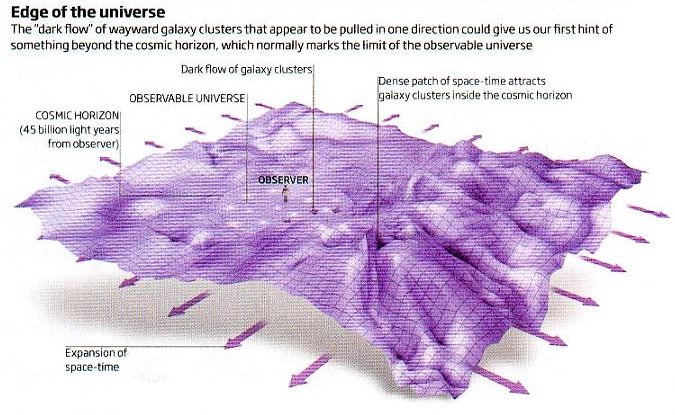Universe Today | Steve Nerlich | 2011 Mar 26
The hypothetical dark flow seen in the movement of galaxy clusters requires that we can reliably identify a clear statistical correlation in the motion of distant objects which are, in any case, flowing outwards with the expansion of the universe and may also have their own individual (or peculiar) motion arising from gravitational interactions.
For example, although galaxies have a general tendency to rush away from each other as space-time expands between them, the Milky Way and the Andromeda Galaxy are currently on a gravitationally bound collision course.
So, if you are interested in the motion of the universe at a large scale, it’s best to study bulk flow – where you step back from consideration of individual objects and instead look for general tendencies in the motion of large numbers of objects.
Very large scale observations of the motion of galaxy clusters were proposed by Kashlinsky et al in 2008(1) to indicate a region of aberrant flow, inconsistent with the general tendency in the motion and velocity expected by the expansion of the universe – and which cannot be accounted for by localized gravitational interactions.
On the basis of such findings, Kashlinsky has proposed that inhomogeneities in the early universe may have existed prior to cosmic inflation – which would represent a violation of the currently favored standard model for the evolution of the universe, known as the Lambda Cold Dark Matter (Lambda CDM) model.
The aberrant bulk flow might result from the existence of a large concentration of mass beyond the edge of the observable universe – or heck, maybe it is another adjacent universe. Since the cause is unknown – and perhaps unknowable, if the cause is beyond our observable horizon – the astronomical interrobang ‘dark’ is invoked – giving us the term ‘dark flow’.
To be fair, a lot of the more ‘out there’ suggestions to account for these data are made by commentators of Kashlinsky, rather than Kashlinsky and fellow researchers themselves – and that includes use of the term dark flow. Nonetheless, if the Kashlinsky data isn’t rock solid, all this wild speculation becomes a little redundant – and Occam’s razor suggests we should continue assuming that the universe is best explained by the current standard Lambda CDM model.
The Kashlinsky interpretation does have its critics. For example, Dai et al(3) have provided a recent assessment of bulk flow based on the individual (peculiar) velocities of type 1A supernovae.
The Kashlinsky analysis is based on observations of the Sunyaev–Zel’dovich effect – which involves faint distortions in the cosmic microwave background (CMB) resulting from CMB photons interacting with energetic electrons – and these observations are only considered useful for identifying and observing the behavior of very large scale structures such as galaxy clusters. Dai et al instead use specific data points – being standard candle Type 1a supernovae observations – and look at the statistical fit of these data to the expected bulk flow of the universe.
So, while Kashlinsky et al say we should ignore the motion of individual units and just look at the bulk flow – Dai et al counter with saying we should look at the motion of individual units and determine how well those data fit an assumed bulk flow.
It turns out that Dai et al find the supernovae data can fit the general trend of bulk flow proposed by Kashlinsky – but only in closer (low red shift) regions. More significantly, they are unable to replicate any aberrant velocities. Kashlinsky measured an aberrant bulk flow of more than 600 kilometers a second, while Dai et al found velocities derived from Type 1a supernovae observations to best fit a bulk flow of only 188 kilometers a second. This is a close fit with the bulk flow expected from the Lambda CDM model of the expanding universe, which is around 170 kilometers a second.
Either way, it’s all down to a statistical analysis of general tendencies. More data would help here.
- A Measurement of Large-Scale Peculiar Velocities of Clusters of Galaxies: Results and Cosmological Implications - A Kashlinsky et al
- Astrophysical Journal Letters 686(2) L49 (2008 Oct 20) DOI: 10.1086/592947
arXiv.org > astro-ph > arXiv:0809.3734 > 22 Sep 2008
- Astrophysical Journal Letters 686(2) L49 (2008 Oct 20) DOI: 10.1086/592947
- A Measurement of Large-Scale Peculiar Velocities of Clusters of Galaxies: Technical Details - A Kashlinsky et al
- Astrophysical Journal 691(2) 1479 (2009 Feb 01) DOI: 10.1088/0004-637X/691/2/1479
arXiv.org > astro-ph > arXiv:0809.3733 > 22 Sep 2008 (v1), 04 Feb 2009 (v2)
- Astrophysical Journal 691(2) 1479 (2009 Feb 01) DOI: 10.1088/0004-637X/691/2/1479
- Measuring the cosmological bulk flow using the peculiar velocities of supernovae - DC Dai, WH Kinney, D Stojkovic
- arXiv.org > astro-ph > arXiv:1102.0800 > 03 Feb 2011
Accepted for publication in Journal of Cosmology and Astroparticle Physics
- arXiv.org > astro-ph > arXiv:1102.0800 > 03 Feb 2011
<-- Previous

